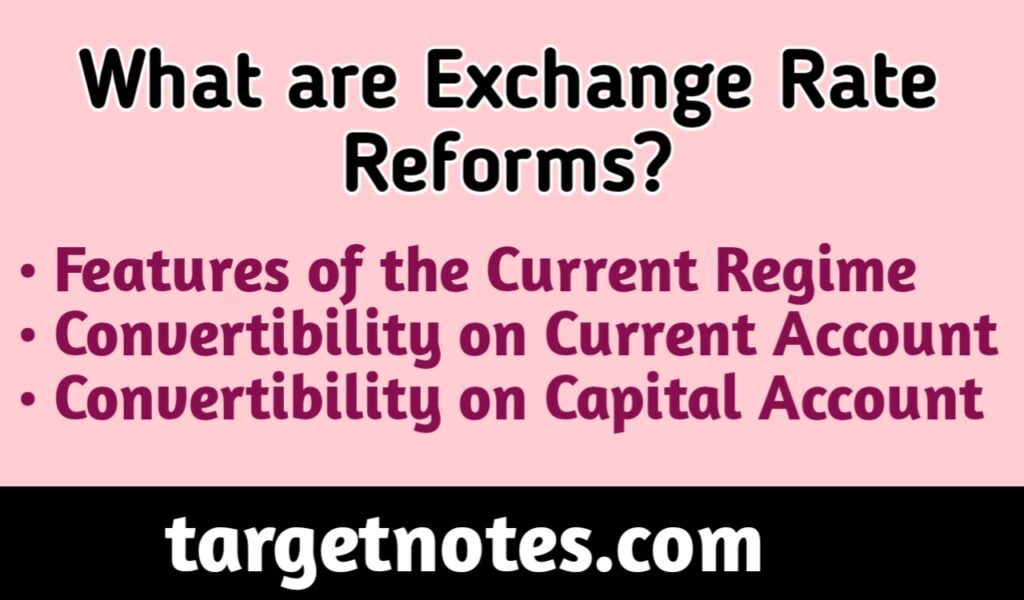
What are Exchange Rate Reforms?
Contents
What are Exchange Rate Reforms?
Exchange rate reforms have proceeded gradually beginning with a two-stage cumulative devaluation of rupee by about 20 per cent effected in July 1991. Subsequently, the Liberalised Exchange Rate Management System (LERMS) was introduced in 1992, which was later replaced by the Unified Exchange Rate System (UERS) in 1993. The net result was an effective devaluation of the rupee by around 35 per cent in nominal terms and 25 per cent in real terms between July 1991 and March 1993.
Features of the Current Regime
The principal features of the current exchange rate regime in India can be briefly stated as follows.
(i) The rates of exchange are determined in the market.
(ii) The freely floating exchange rate regime continues to operate within the framework of exchange control.
(iii) Current receipts are surrendered (or deposited) to the banking system, which in turn, meets the demand for foreign exchange.
(iv) RBI can intervene in the market to modulate the volatility and sharp depreciation of the rupee. It effects transactions at a rate of exchange, which could change within a margin of 5 per cent of the prevailing market rate.
(v) The US dollar is the principal currency for the RBI transactions.
(vi) The RBI also announces a Reference. Rate based on the quotations of select banks on Bombay at twelve noon every day. The Reference Rate is applicable to SDR transactions and transactions routed through the Asia Clearing Union.
In short, the India rupee has matured to a regime of the floating exchange rate from the earlier versions of a ‘managed float’.
Convertibility on Current Account
The current regime of the exchange rate has been accompanied by full ‘Convertibility on current account with effect from August 20, 1994. Accordingly, several provisions like remittances for service, education, basic travel, gift remittances, donation, and provisions of the Exchange Earners’ Foreign Currency Account (EEFCA) were relaxed.
In a further move, announced in 1997, the RBI Liberalised the existing regulations in regard to payments for various kinds of feasibility studies, legal services, postal imports and purchases of designs and drawings. With this, India acquired a status called as the IMF Article VIII Status.
By attaining the Article VIII status, India has reached a position by which it can instill confidence among the international investor community, paving the way for further inflow of foreign capital. Further, India is also committed to allowing free outflow of current account payments (like interest) even if there is a serious foreign exchange crisis.
Not with standing the above, the government still retains many controls on current account.
Among these, the following may be specifically mentioned:
- Repatriation of export proceeds within six months;
- Caps on the amounts spent on the purchase of services abroad;
- Restrictions on the repatriation of interest on rupee debt;
- Dividend-balancing for FDI in some consumer goods industries;
- Restrictions on the repatriation of interest on NRI deposits;
- The rupee is not allowed to be officially used as international means of payment. Indian banks are not permitted to offer two-way quotes to NRIs or-non-resident banks.
With the help of these controls, the governments can significantly alter the flow of foreign exchange and the exchange rate of rupee. Additionally, the RBI can influence the exchange rate through direct purchase and sale of foreign exchange in the market.
Convertibility on Capital Account
Drawing on the experience of the past decade and a half, the extent and timing of capital account Liberalisation is sequenced with other reforms like strengthening of banking systems, fiscal consolidation, market development and integration, trade Liberalisation, etc. all of which are in tune with the changing domestic and external economic environment.
A hierarchy is thus established in the sources and types of capital flows. The priority has been to liberalise inflows relative to outflows, but all outflows associated with inflows have been totally freed. Among the type of inflows, FDI is preferred for its stability, while short-term external debt is avoided. A differentiation is made between Corporates, individuals and banks.
For outflows, the hierarchy for liberalisation has corporate at the top, followed by financial intermediaries and individuals. Restrictions have been eased for corporate Seeking investments and acquisitions abroad, which strengthen their global presence. Banks and financial intermediaries are considered a source of greater volatility as their assets are relatively illiquid and their liabilities are demandable.
They are thus susceptible to self-fulfilling crisis of confidence leading to contagion effect. In view of this, liberalisation for outflows in this sector has been tied to financial sector reforms. For individuals, residents are treated differently from non-residents, and non-resident Indians are accorded a well-defined intermediate status between residents and non-residents.
Intervention by RBI
The current exchange rate regime, introduced in 1993, the RBI has been, actively intervening in the foreign exchange market with the objective of maintaining the real effective exchange rate (REER) stable.
The RBI uses two types of intervention in this regard:
(i) Direct Intervention : It refers to purchases and sales in international currency (i.e. US dollars and euro) both on the spot and also in forward markets.
(ii) Indirect Intervention: It refers to the use of reserve requirements and interest rate flexibility to smoothen temporary mismatches between demand and supply of foreign currency.
Intervention by the RBI has raised a question as to whether or not there should be an exchange rate band within, which the central bank should allow the currency to fluctuate. The Tarapore Committee in its report on Capital Account Convertibility had, while suggesting transparency in the exchange rate policy of the central bank recommended a band within which it would allow the currency to move.
The RBI has been, in contrast, saying that there cannot be such rigidities in exchange rate policy, and, therefore, the bank should have the right to intervene at its discretion. Such interventions are considered necessary till the rupee is made fully convertible.
IMPORTANT LINK
- What is the Exchange Rate System in India?
- Evolution of foreign exchange market in India
- Meaning and importance of export finance.
- Role of Export-Import Bank in Financing India’s Foreign Trade
- How Commercial banks Export Finance to Overseas Importers?
- Explain packing credit in detail?
- What is Post-shipment credit?
- What is Pre-shipment or packing credit?
- Explain Export Credit in India?
- Institutions Providing Finance and Credit Facility for Foreign Trade
- What is Risk Analysis?
- Explain Political risks in detail? and its Types
- What are the types of Risks. Explain in detail?
- Meaning and Types of commercial risks
- How can we minimize foreign trade risks?
- What are Arbitrage operations?
- Difference between Spot Market and Forward Market
- What is spot exchange?
- Agency agreement: Meaning, Features and Advantages
- Functions of Foreign Exchange markets
- structure of Foreign exchange markets
Disclaimer






